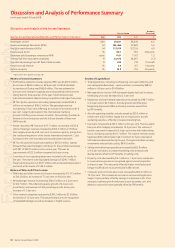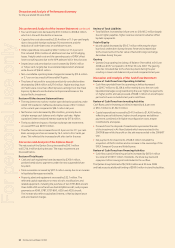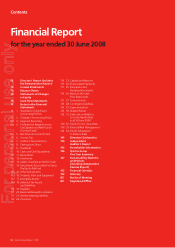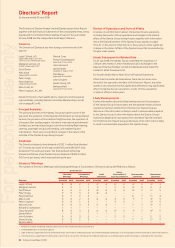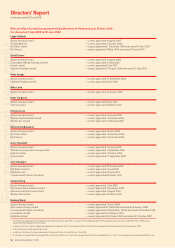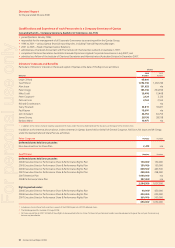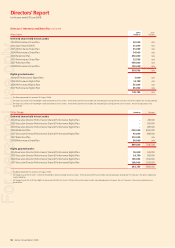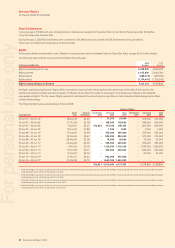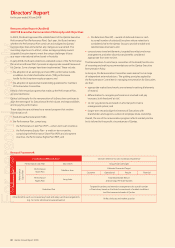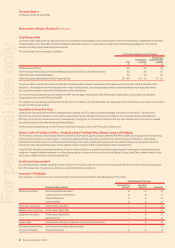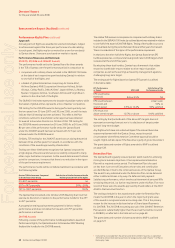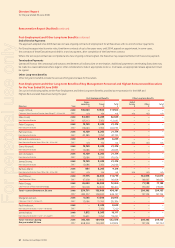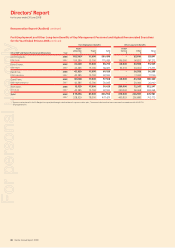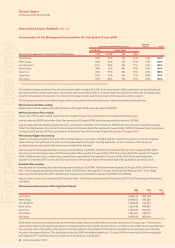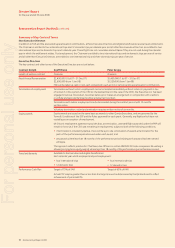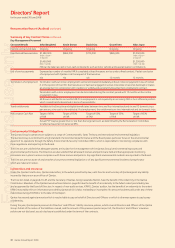Qantas 2008 Annual Report Download - page 64
Download and view the complete annual report
Please find page 64 of the 2008 Qantas annual report below. You can navigate through the pages in the report by either clicking on the pages listed below, or by using the keyword search tool below to find specific information within the annual report.
62 Qantas Annual Report 2008
Directors’ Report
for the year ended 30 June 2008
Short-term Employee Benefits
Fixed Annual Remuneration
Salary decisions are based on FAR, which involves a guaranteed salary
level from which superannuation and certain other benefi ts, such as
a maintained motor vehicle, can be deducted at the election of the
Executive on a salary sacrifi ce basis.
FAR is set with reference to market data, refl ecting the scope of the role,
the unique value of the role and the performance of the person in the
role. FAR is reviewed annually and overall refl ects a middle-of-the-
market approach, as compared to similar comparative roles within
Australia, with particular reference to large public companies for
the most senior roles.
Cash FAR, as disclosed in the remuneration tables, is the FAR
remaining after salary sacrifi ce components such as motor vehicles
and superannuation have been deducted.
Executives are assumed to use their annual leave benefi t in any year and any
leave not taken at termination will be refl ected in their termination benefi t.
Non-Executive Directors
Non-Executive Director FAR is determined within an aggregate
Directors’ fee pool limit. An annual total pool of $2.5 million was
approved by shareholders at the 2004 AGM. FAR comprises Directors’
fees, Committee fees and superannuation. In addition to FAR, Non-
Executive Directors are paid a travel allowance when attending
overseas Board Meetings.
FAR and payments to Non-Executive Directors refl ect the demands
and responsibilities which are made of Non-Executive Directors and
refl ect the advice of independent remuneration consultants to ensure
Non-Executive Director FAR and salary sacrifi ce payments are appropriate.
The level of Non-Executive Director FAR is reviewed annually.
Non-Executive Directors do not receive any performance
related remuneration.
Cash Incentives – Performance Cash Plan
Purpose
The PCP is a cash incentive paid to Executives when the Qantas Group’s
key fi nancial target is achieved over the year.
Approach
A cash pool for PCP awards to Executives is triggered if a threshold
level of performance against the Qantas Group fi nancial target is met.
This means the Qantas Group fi nancial result for the year is the fi rst
hurdle required to be satisfi ed.
For each participating Executive, the target reward under the
PCP is set as a percentage of FAR. This percentage varies according
to the Executive’s level of responsibility. There is also differentiated
distribution of the bonus payment pool to Executives based on
individual performance.
Performance Measures and Rationale
Determining Payment Pool
For 2007/08, the fi nancial target was profi t before related income
tax expense (PBT) adjusted for restructuring charges, the impact
of approved accounting policy changes, adjustments for volatility
from the mark-to-market of open hedge instruments under
Accounting Standard AASB 139 Financial Instruments: Recognition
and Measurement and any expense or provision required due
to freight cartel litigation.The selection of PBT refl ects the use of
this measure as a key budget and fi nancial measure both at Group
and segment level within the Qantas Group.
This single measure applies to all Executives and results in no payment
when profi tability hurdles are not achieved.
The target is set annually as part of the budgeting process and approved
by the Board. At the conclusion of the year, the PBT result is provided to
the Board. The Board approves the size of the pool based on these results.
The ‘at target’ pool, i.e. the amount that would deliver the full PCP
award to all participating Executives, is available when the target
approved by the Board is met.
The threshold for payment is 75 per cent of target PBT. At the threshold,
half of the PCP pool is available for distribution.
In the seven years that the PCP has been in place, the full ‘at target’
payment has been achieved twice and exceeded three times, with
partial payment on one occasion and one year of nil payment.
Determining Individual Payments
Differentiation of payments among Executives based on individual
performance is an important part of the approach to performance
management at Qantas. The performance of each individual is assessed
against their Key Performance Indicators (KPIs) for the year, and an
Individual Performance Factor (IPF) assigned at year end. At the
beginning of each year, performance objectives are set in the areas
of customer service, operational performance, people achievements
and fi nancial performance. At the end of the year, each Executive’s
contribution is assessed against these criteria. Their contribution
is also considered relative to other Executives in determining their IPF.
An Executive’s actual reward is calculated by multiplying their ‘at target’
payment by their IPF. IPFs are generally in the range of 0.8 to 1.2 but
can be down to 0 or up to 2.0. Across the group, IPFs are targeted
to an average of 1, ensuring that differentiation occurs, but without
increasing the cost of the bonus pool.
For example, if the Qantas Group PBT target is achieved and the Board
awards 100 per cent of the PCP pool, the reward under this Plan for
a Manager on a FAR of $120,000 with an ‘at target’ PCP opportunity
of 10 per cent and an IPF 0.9 would be:
$120,000 (FAR)
x 10 per cent (‘at target’ opportunity)
x 100 per cent (PCP pool if Group target is met)
x 0.9 (IPF based on differentiated assessment)
= $10,800.
Non-cash Benefits
Non-cash benefi ts, as disclosed in the remuneration tables, include
salary sacrifi ce components such as motor vehicles, memberships
of appropriate professional associations, taxation and fi nancial advice
and travel entitlements.
Directors’ and Offi cers’ liability insurance has not been included in
the remuneration since it is not possible to determine an appropriate
allocation basis.
Concessionary Travel Entitlements
Travel concessions are provided to all permanent Qantas employees,
consistent with practice in the airline industry. Travel at concessionary
prices is on a sub-load basis, i.e. subject to considerable restrictions
and limits on availability. It includes specifi ed direct family members
or parties.
In addition to this and consistent with practice in the airline industry,
a small number of Directors and Senior Executives and their specifi ed
direct family members or parties are entitled to a number of free trips
for personal purposes. Eligibility for new participants is generally
restricted to members of the Qantas Executive Team.
Remuneration Report (Audited) continued
For personal use only


